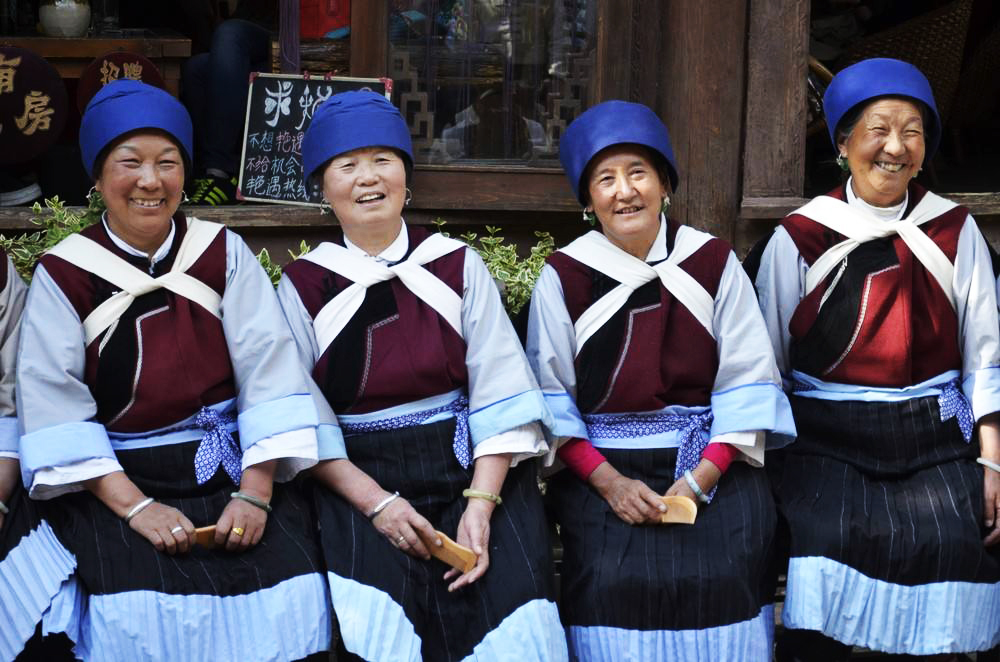
In the northwest region of Yunnan province, surrounded by the majestic Jade Dragon Snow Mountain, the Naxi people have carved out an enclave over hundreds of years. Like the Tibetan, Pumi, and Yi ethnic minorities, they are thought to be descendants of the ancient Qiang[1] people, a nomadic tribe that once lived between Gansu and Shaanxi.
Sometime between the 1st and 10th century the Naxi’s ancestors migrated south towards Tibet and had begun settling in modern-day Baisha and Lijiang by the year 3 AD. From there they are rumoured to have separated into three groups; those who remained in Baisha were known as the Naxi; those who went to Dali became the Bai ethnic minority; and those who moved to the region around Lugu Lake became the Mosuo people. That being said, the Bai and Mosuo people fiercely refute this origin story!
Not long thereafter a Naxi family known as the Mu clan rose to prominence in Lijiang but were eventually demoted to Tusi[2] by the Yuan Dynasty (1271-1368). During the Ming Dynasty (1368-1644), taxes and tributes flowed from the Mu family to the Ming court and the court, in their turn, relied on the Mu family to keep the peace and control the ethnic groups of the region. In other words, the Mu clan still got to lead and the Ming court had someone else to do their dirty work for them! A similar arrangement took placing during the Qing Dynasty (1644-1912) but was gradually abolished not long before imperial rule collapsed.
Nowadays there are approximately 300,000 Naxi people living in China. The majority are concentrated in Lijiang Naxi Autonomous County of Yunnan, but there are smaller communities throughout northwest Yunnan, southwest Sichuan, and the Tibetan Autonomous Region. Their spoken language has four tones, much like Mandarin Chinese, and is divided into two main dialects: Eastern and Western. The Western dialect is the standard, while the Eastern dialect is spoken by the Mosuo people and other related ethnic groups. Yet it is their written language that has garnered much fame.
They use two writing systems known as Dongba script and Geba script, both of which are over 1,000 years old. They may not sound so special at first, but Dongba script is the last known hieroglyphic writing system still in use today. It incorporates approximately 1,500 pictographs and is referred to as “Serjelvje” or “Wooden and Stone Script” by the Naxi. It is predominantly used by Dongba shamans, who are priests in the Naxi’s indigenous religion. Geba script is a glyphic writing system that is only used to transcribe mantras or annotate Dongba pictographs. Consequently there are only 686 Geba characters.
The most famous example of Dongba script is a religious work known as Dongba Jing, which was written during the Tang Dynasty (618-907) and consists of more than 2,000 volumes! It describes the progression of Naxi society from slavery to feudalism and covers a wide range of subjects, including their religion, language, local customs, literature, astronomy and geology. The work includes “The Creation of the World”, an epic about the origin of mankind, and “The Dongba Dance Manual”, which records 60 different styles of dance and is one of the oldest dance manuals in existence. So if you want to learn some of the oldest dance moves in the world, we suggest you start studying Dongba script right away!
The Naxi traditionally live in two-storey log cabins. The exterior is made up of a large courtyard and the interior is marked by “lanes”, with each “lane” containing three rooms joined by a corridor. The houses are often beautifully decorated, with intricately engraved wooden doors on the buildings and an abundance of fragrant flowers in the courtyard. The main house will always face south or east, as the Naxi believe this will trap good luck as it arrives!
Notes:
- This is not to be confused with the Qiang ethnic minority who occupy parts of Sichuan province.
- Tusi: Chieftains or tribal leaders who were permitted to rule over a certain region and were acknowledged as imperial officials but who ultimately answered to the Emperor.